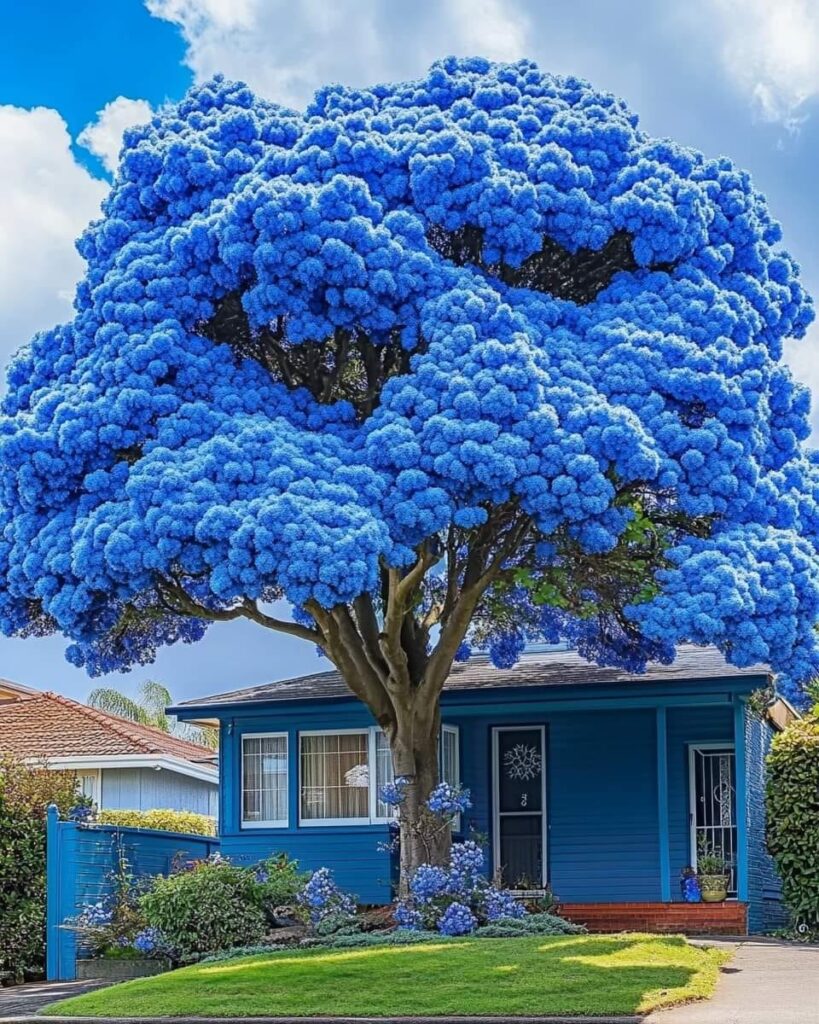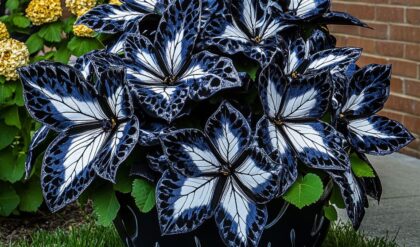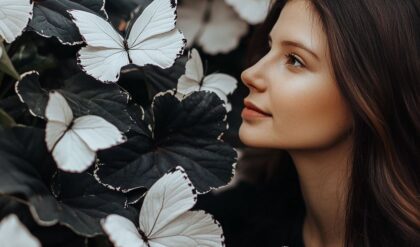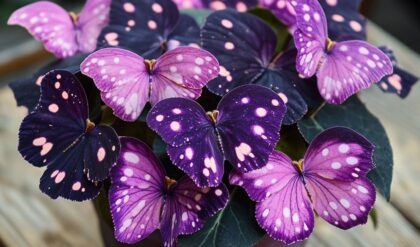The jacaranda tree, scientifically known as Jacaranda mimosifolia, is not just a botanical marvel; it embodies a rich tapestry of cultural significance, ecological roles, and aesthetic beauty. Originating from the seasonally dry tropics of South America, this flowering tree has been embraced worldwide for its striking blue-violet blooms that create breathtaking displays in urban landscapes and natural habitats alike .

Imagine walking through a city street or a quiet park during late spring or early summer, where vibrant lavender petals blanket the ground like a natural carpet, creating a contrast against lush greenery. This visual spectacle can evoke feelings of serenity and nostalgia, connecting us to the cycles of nature.

The jacaranda’s blossoms serve not only as a feast for the eyes but also for the senses, inviting bees and butterflies to partake in their nectar, thereby supporting local ecosystems. Indeed, their role as shade-loving ornamental trees has made them popular in gardens and public spaces across warm regions such as Southern California and parts of Africa, notably Pretoria, which is famously adorned with these trees .

However, the jacaranda’s presence is not universally cherished. Some individuals have expressed frustration over the mess created by fallen blooms and the potential allergens they produce, leading to a love-hate relationship with this iconic tree 10. This dichotomy raises intriguing questions: What does it mean for a species to be both adored and criticized? How do we balance nature’s beauty against practical inconveniences in our increasingly urbanized world? Just as the jacaranda can provoke disparate sentiments, so too can other natural wonders; they remind us of the delicate interplay between human perception and environmental existence.

Culturally, jacarandas hold significant meaning in various societies, symbolizing rebirth and renewal in places like Mexico, where they bloom vibrantly alongside the rhythm of life in cities like Oaxaca . They represent not just flora, but history, identity, and community pride — uniting people under their sprawling canopies and fostering connections among diverse cultures. Each blossom might tell a story, perhaps of youth spent playing beneath their boughs or lovers sharing moments in their shaded glades.

In conclusion, the jacaranda tree transcends its role as merely an ornamental plant; it functions as a symbol of nature’s complexity. It challenges us to appreciate beauty while confronting the realities of cohabitation with nature. As we witness the ephemeral blooms, we are reminded of the transient nature of existence itself, urging us to find harmony with our environment amidst life’s inevitable messiness.

Jacaranda ‘Blue Bliss’
The ‘Blue Bliss’ jacaranda tree is a captivating sight with its brilliant blue blossoms that create a dense, cloud-like canopy. This tree is a showstopper in any landscape, offering a stunning burst of color that contrasts beautifully against its surroundings.
Plant care guide:
- Light: Prefers full sun to thrive and produce its vibrant blooms.
- Water: Water regularly, especially during dry periods, but allow the soil to dry slightly between waterings.
- Soil: Requires well-draining soil with a slightly acidic to neutral pH.
- Temp: Best grown in temperatures between 65-85°F (18-29°C).
- Humidity: Enjoys moderate to high humidity levels, typical of subtropical environments.
Organic fertilizers: Apply a slow-release, balanced organic fertilizer in spring to promote healthy growth and abundant flowering.
Garden decoration ideas: The ‘Blue Bliss’ jacaranda is perfect for planting as a centerpiece in large gardens or along streets where its breathtaking blooms can be admired by all. It also complements modern architecture, adding a touch of natural elegance to urban landscapes.

Tree ‘Pink Blossom’
The ‘Pink Blossom’ tree is a stunning ornamental feature that transforms any landscape with its breathtaking canopy of soft pink flowers. This tree is perfect for creating a romantic, fairy-tale atmosphere in gardens or along streets.
Plant care guide:
- Light: Requires full sun to flourish, with at least 6 hours of direct sunlight daily.
- Water: Needs regular watering, especially during dry spells, to keep the soil moist.
- Soil: Thrives in well-draining, slightly acidic to neutral soil.
- Temp: Prefers mild to warm climates, ideally between 50-80°F (10-27°C).
- Humidity: Tolerates a range of humidity levels but does best in moderate humidity.
Organic fertilizers: Feed with a balanced organic fertilizer in the spring to support vigorous growth and abundant blooms.
Garden decoration ideas: Plant this tree as a standalone feature in large gardens or parks, where its full grandeur can be appreciated. It can also be planted along avenues or driveways to create a picturesque, blooming tunnel during the flowering season.

Tree ‘Purple Majesty’
The ‘Purple Majesty’ tree is an eye-catching addition to any landscape, known for its vibrant purple blooms that create a striking contrast against the green foliage. This tree adds a royal touch to gardens, parks, and residential streets.
Plant care guide:
- Light: Prefers full sun to partial shade, with at least 6 hours of sunlight per day.
- Water: Requires regular watering, especially during dry periods, to maintain its lush appearance.
- Soil: Thrives in well-draining, fertile soil with a slightly acidic to neutral pH.
- Temp: Best suited for temperate to warm climates, ideally between 55-85°F (13-29°C).
- Humidity: Tolerates various humidity levels but flourishes in moderate to high humidity.
Organic fertilizers: Apply a balanced organic fertilizer in early spring to encourage healthy growth and vibrant flowers.
Garden decoration ideas: Plant this tree as a focal point in large gardens or along property lines to create a colorful border. Its dramatic presence is also perfect for framing driveways or as a centerpiece in community parks.

Tree ‘Sunset Radiance’
The ‘Sunset Radiance’ tree is a breathtaking natural wonder, known for its unique blend of vibrant orange and purple blossoms that evoke the beauty of a sunset. This majestic tree is perfect for creating a dramatic focal point in any landscape.
Plant care guide:
- Light: Requires full sun to thrive, ensuring the brightest and most vivid flower colors.
- Water: Water regularly, especially in hot, dry weather, to keep the soil consistently moist but well-drained.
- Soil: Prefers fertile, well-draining soil with a slightly acidic to neutral pH.
- Temp: Best grown in warm to temperate climates, ideally between 60-85°F (16-29°C).
- Humidity: Tolerates a wide range of humidity levels but does best in moderate to high humidity.
Organic fertilizers: Use a high-phosphorus organic fertilizer in early spring to promote abundant flowering and enhance the vivid colors.
Garden decoration ideas: This tree is perfect as a centerpiece in large gardens or as a statement piece in parks. It also works beautifully as a backdrop for outdoor events, providing a stunning natural canopy.

Tree ‘Cotton Candy Dream’
The ‘Cotton Candy Dream’ tree is a striking and whimsical sight, with its dense, fluffy pink blossoms that resemble clouds of cotton candy. This enchanting tree is perfect for adding a touch of fantasy to urban landscapes or large gardens.
Plant care guide:
- Light: Thrives in full sun to partial shade, providing the best conditions for its vibrant blooms.
- Water: Requires regular watering, especially during dry spells, to maintain its lush appearance.
- Soil: Prefers well-draining, fertile soil with a slightly acidic to neutral pH.
- Temp: Ideal for temperate climates with temperatures ranging from 55-75°F (13-24°C).
- Humidity: Prefers moderate humidity but can tolerate lower levels in drier climates.
Organic fertilizers: Apply an organic, slow-release fertilizer in early spring to support healthy growth and enhance the fullness of the blossoms.
Garden decoration ideas: Perfect as a statement tree in residential streets or public spaces, creating a magical atmosphere. It also serves as a beautiful backdrop for outdoor gatherings, weddings, and other special events.

Tree ‘Lavender Majesty’
The ‘Lavender Majesty’ tree is a captivating addition to any urban landscape, with its towering structure and dense, pastel purple blossoms. This majestic tree is perfect for creating a serene and tranquil environment in city streets or expansive gardens.
Plant care guide:
- Light: Prefers full sun to partial shade, ensuring the best blooming results.
- Water: Needs consistent watering, particularly during dry periods, to maintain its lush, vibrant canopy.
- Soil: Thrives in well-draining, fertile soil with a slightly acidic to neutral pH balance.
- Temp: Grows best in mild climates with temperatures between 60-80°F (16-27°C).
- Humidity: Enjoys moderate humidity, but can tolerate drier conditions if adequately watered.
Organic fertilizers: Use an organic, balanced fertilizer in early spring to support healthy growth and encourage prolific flowering.
Garden decoration ideas: Ideal as a focal point in residential areas or public parks, where its stunning purple blooms can be fully appreciated. It also enhances the aesthetic appeal of any space, making it perfect for peaceful retreats or meditation gardens.

Here are the top 5 Jacaranda nurseries in the United States:
- Monrovia Nursery
- Location: Azusa, California
- Overview: Monrovia is one of the most renowned nurseries in the U.S., offering a wide variety of Jacaranda trees. They are known for their high-quality plants and have been in business for nearly 100 years. Monrovia’s Jacaranda trees are available in many garden centers across the country.
- Moon Valley Nurseries
- Location: Multiple locations across Arizona, California, Nevada, and Texas
- Overview: Moon Valley Nurseries is a leading nursery with locations throughout the southwestern United States. They specialize in large, mature Jacaranda trees, perfect for homeowners looking to add instant shade and beauty to their landscapes.
- Willis Orchard Company
- Location: Cartersville, Georgia
- Overview: Willis Orchard Company offers a range of Jacaranda trees suited for various climates. They focus on providing well-established trees that are ready to thrive in your garden. Their trees are shipped nationwide.
- Plant Delights Nursery
- Location: Raleigh, North Carolina
- Overview: Plant Delights Nursery is known for its unique and rare plant offerings, including Jacaranda trees. They are committed to sustainable gardening practices and offer plants that are hardy and adaptable.
- Fast Growing Trees
- Location: Online Nursery
- Overview: Fast Growing Trees offers Jacaranda trees through their online platform, making it easy to purchase and have them delivered right to your door. They are known for their fast shipping and healthy plants, ensuring your Jacaranda arrives ready to plant.
These nurseries are excellent choices for sourcing Jacaranda trees across the U.S., each offering unique benefits to cater to your gardening needs.




